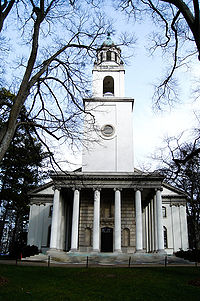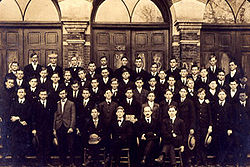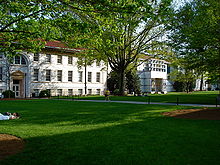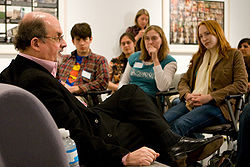历史
Main article: History of Emory University

Glenn Memorial United Methodist Church near the main entrance of Emory University
In 1836, a small group of Methodists from Newton County contemplated the establishment of a new town and college. The town was named Oxford after the school's prestigious British namesake, which graduated the two founders of Methodism, John and Charles Wesley. The college was named after John Emory, an American Methodist bishop who inspired them.
Events preceding the chartering of Emory College began in 1783, when the Georgia State legislature provided for the founding of "a college or seminary of learning." However, general support of education in Georgia was meager until the 1830s, when an educational fad in Germany inspired Georgia Methodists to create a school for manual labor. At the Georgia Methodist Conference in 1834, a preacher known as "Uncle Allen" Turner suggested that Georgia Methodists should develop their own school rather than support Randolph-Macon in Virginia. As a result, the Manual Labor School was created in Covington, Georgia in 1835.
On December 10, 1836, the Georgia General Assembly granted the Georgia Methodist Conference a charter to Emory College, named for John Emory, a popular bishop who had presided at the 1834 conference but had died in a carriage accident in 1835. Two years after the chartering, the college opened its doors, and on September 17, 1838, the college's first president, Ignatius Alphonso Few, and three faculty members welcomed fifteen freshmen and sophomores.

Emory College quad in Oxford, Georgia

Class of 1846 in front of Seney Hall
Emory College imposed a strict environment during most of the nineteenth century. By signing their names into the Matriculation Book, students were bound to obey the "Laws and Statutes of the College," which bound students to their rooms during study hours, and forbade them from leaving the town limits without the president's consent and engaging in immoral activities. Until the presidency of Warren Candler in the 1890s, Emory prohibited intercollegiate sports. He thought the practice "evil, only evil, and that continually," his principle objection being the cost of intercollegiate athletic programs, the temptation of gambling, and the distraction from academics. However, he was not unalterably opposed to athletics, and during his presidency he raised funds for the first gymnasium at Emory and oversaw the creation of the nation's first model intramural program.
Emory College was closed briefly during the Civil War. In the autumn of 1861, every student left to fight, and the college's trustees closed for the duration. During the war, the college's buildings saw duty both as a Confederate hospital and Union headquarters. When Emory reopened in January 1866, the school's library was destroyed and its small endowment was depleted. Only with the aid of a state G.I. Bill could students afford to resume their education.
In the years following the Civil War, Emory, along with the rest of the South, struggled to overcome financial devastation. The first step toward financial stability came in 1880, when Emory President Atticus G. Haygood preached a Thanksgiving Day sermon expressing gratitude for the end of slavery captured the attention of George Seney, a Brooklyn banker and Methodist. Seney gave Emory College $5,000 to repay its debts, $50,000 for construction, and $75,000 to establish a new endowment. Over the years, Seney invested more than a quarter-million dollars into Emory College, helping to erect the administration building in Oxford that bears his name.
Under the direction of President Haygood's direction, Emory College began to offer many technical and professional subjects in addition to courses required for degrees. By the turn of the century, Emory had evolved its traditional liberal arts program into a broad curriculum encouraging students to pursue degrees in science, study in theology and law, and even learning and expertise in technology and tool craft. The technology department was launched by President Isaac Stiles Hopkins, a polymath professor at Emory College, who was later convinced by state legislators to become the first president of what is now the Georgia Institute of Technology.
The course of Emory's history changed dramatically when, in November 1979, Robert and George Woodruff presented the institution with a gift of $105 million in Coca-Cola stock. At the time this was the largest single gift to any institution of higher education in American history, and it made a profound impact on Emory's direction in the next two decades, boosting the university to the top ranks of American research universities.
组织
The College of Arts and Sciences is the undergraduate institution of Emory University with 66 majors, 53 minors, 17 joint concentrations, and 10 interdepartmental programs leading to a bachelor's degree. It enrolls approximately 6,000 undergraduate students. The Oxford College of Emory University, located in Oxford, Georgia, enrolls about 700 students. Students at Oxford traditionally complete their first two years of their degree at Oxford and then continue at the College of Arts and Sciences (located on the Atlanta campus) to complete their bachelor's degrees. Because of its size, Oxford College provides low student-teacher ratios in classrooms and a close-knit social community typical of liberal arts colleges.
The Graduate School has degree programs in 26 divisions in which students receive either master's or doctoral degrees. The Candler School of Theology is allied with the United Methodist Church, but enrolls students from 45 different denominations. The Goizueta Business School was ranked 20th nationally by U.S. News and 18th by Forbes for their MBA program; the undergraduate program was ranked 4th by BusinessWeek in 2007. Emory Law School is currently ranked 20th by U.S. News and World Report.
The Emory Healthcare System is the largest healthcare provider in Georgia and educates doctors, nurses, and other health professionals. The Emory University School of Medicine enrolls approximately 425 medical students, 1,000 residents and fellows, and 350 allied health students. Collaborating with the nearby Centers for Disease Control and Prevention and other public health organizations, the Rollins School of Public Health has about 800 graduate students. The Nell Hodgson Woodruff School of Nursing enrolls approximately 175 undergraduate students and 175 graduate students.
The Financial Aid Office awards need-based financial aid to all qualifying students through institutional and federal grant and loan packages. In January 2007, the University announced its newest aid program, Emory Advantage. Emory Advantage seeks to help undergraduate dependent students from families with assessed annual incomes $100,000 or less who demonstrate a need for financial aid. The program reduces the amount of money borrowed to pay for an undergraduate Emory degree. The goal is to make an Emory education attainable for any qualified student, regardless of income.
The Loan Replacement Grant (LRG) replaces loans for dependent undergraduate students whose families' assessed annual incomes are $50,000 or less. Grants replace need-based loans to cover expenses including tuition, room, and board. The eligible grant amount represents the student's self-help portion normally given in the form of a loan.
The Loan Cap Program (LCP) caps cumulative need-based debt at $15,000 for dependent undergraduate students whose families' assessed annual incomes are between $50,001 and $100,000. With the Loan Cap Program, students receive a standard financial aid award for freshman and sophomore years. This estimated award could include federal or state aid, institutional loans or grants, or Work-Study. After a student has accrued a total of $15,000 in need-based loans, Emory will provide grants to cover any remaining need-based funding incurred through degree completion.
学术
Profile

Main Quad on Emory's Druid Hills Campus
Emory's student body consists of 6,980 undergraduates and 5,950 graduate and professional students as of 2010. Its student body is the most ethnically and religiously diverse of any of the top twenty national research universities, with 12,755 students from fifty states and 106 countries. For the undergraduate class of 2012, Emory received a record 17,499 applications, and accepted 26.6% of them. Academically, the incoming freshman class earned an average GPA of 3.82 in high school. Their median SAT scores range from 1320 to 1460 for the combined critical reading and math sections. In terms of admission selectivity, The Princeton Review gave Emory a score of 99 out of 99.
Emory University has four schools for undergraduates: College of Arts and Sciences (formerly Emory College), Oxford College, the Goizueta Business School, and the Nell Hodgson Woodruff School of Nursing. The university's graduate and professional schools include the Graduate School (formerly the Graduate School of Arts and Sciences), Candler School of Theology, Goizueta Business School, School of Law, School of Medicine, Rollins School of Public Health, and Nell Hodgson Woodruff School of Nursing. Undergraduate students are invited to apply to the business school and nursing school after four semesters at either Emory College or Oxford College.
After the installation as James W. Wagner as President of Emory, a joint program in engineering was introduced in collaboration with the Georgia Institute of Technology. The program allows Emory students to enroll in engineering classes at GeorgiaTech throughout the course of their term at Emory. At the completion of the required courseload at the end of 4 years, students typically graduate with a degree from Emory College or the Goizueta Business School and an engineering degree from GeorgiaTech. The program has been instrumental in strengthening Emory's reputation as a college with a wide spectrum of opportunities.
After graduation, 42% of undergraduates plan to continue to graduate or professional school; 30% of those pursue a medical degree; and 20% plan to pursue a law degree. Emory has matriculated 18 Rhodes Scholars and 10 Marshall Scholars, and houses a chapter of Phi Beta Kappa, the oldest and most prestigious national academic honor society. Two-thirds of all Emory College classes have fewer than 20 students; 7% have more than 50. The university practices need-blind admissions and meets 100% of the admitted students' demonstrated need. More than 40% of students receive financial aid, with the average grant being $28,425. Also, Emory recently created a nationally recognized program called Emory Advantage, which helps reduce debt for undergraduate students and families with incomes and assets less than $100,000 per year.
Rankings
|
|
University rankings (overall)
|
|
| ARWU World |
100 |
| ARWU North & Latin America |
62 |
| Forbes |
59 |
| Times Higher Education |
62 |
| USNWR National University |
17 |
| WM National University |
100 |
In the 2010 U.S. News & World Report ranking of undergraduate programs at doctoral granting institutions, Emory ranked 17th (tied with the Rice University and Vanderbilt University), and has been ranked as high as 9th by the same publication in the past . Emory has also been ranked among top 40 universities in the world according to Global University Ranking Additionally, Emory is one of twenty-five top schools in the nation tapped as a "New Ivy" in Kaplan/Newsweek's 2007 "How to Get Into College Guide" and is ninth in the country for best values among private universities in the 2008 Kiplinger's Personal Finance Magazine. Its undergraduate business program ranked 7th nationally by BusinessWeek in 2010, and has been ranked as high as 4th by the publication in the past.
In U.S. News & World Report's "America's Best Graduate Schools 2009," Emory's medical school ranked 22nd for research and 46th for primary care, while the law school ranked 20th. Among business schools in the United States, the Goizueta Business School was ranked 22nd by U.S. News & World Report in 2009 and 23rd by BusinessWeek in 2008. The Rollins School of Public Health was ranked seventh by U.S. News & World Report, while the Nell Hodgson Woodruff School of Nursing was ranked 26th. The political science, English, and history departments of Emory Graduate School frequently rank in the top 20 of their respective disciplines among U.S. universities. Their African history and social psychology concentrations rank within the top ten, coming in at eight and nine respectively.
Student life
Residential Life
Emory requires its students to live on campus for the first two years of undergraduate life. This requirement is justified by the administration as an effort to help "foster a sense of community and involvement in college life." Thus more than 70% of undergraduates live on campus. All freshmen are housed in one of nine residences on the Druid Hills campus. Sophomores may elect to live on the Druid Hills campus or in the Clairmont Tower, which is located on the Clairmont Campus. Juniors and Seniors may elect to live off-campus or on the Clairmont campus.
A new Freshman Quad is under construction. Currently, the new freshman residential complex contains three residence halls—Turman, Few, and Evans Halls—all LEED-certified. Freshman Hall Four is under construction and is slated to open in Fall 2010. The freshman quad will include as many as 8 buildings to centralize freshman living arrangement.
Fraternities have existed on Emory's campus as early as 1840. One early chronicler makes the case that Emory's "temple" of the Mystic Seven may have been the first chapter of a national fraternity established anywhere in the South. Today, the Greek-letter sororities and fraternities play an important part in leavening Emory's campus life. For undergraduates, Greek life comprises approximately 30% of the Emory student population. The Office of Greek Life recognizes 12 fraternities and 13 sororities. Eleven fraternities have on-campus housing located on Eagle Row. Ten sororities live in Sorority Village, a series of townhouses facing the fraternity houses on Eagle Row. Greek Life is an important social engagement for students, but it is not totally exclusive like at other schools. Students from different sororities and fraternities regularly socialize. The college's emphasis on on-campus housing helps students make many friends inside and outside the Greek system. Emory also has four secret societies—the D.V.S. Senior Honor Society, the oldest society, founded in 1902; Ducemus; the Order of Ammon; and the Paladin Society.

Dooley, the unofficial mascot of Emory University
Traditions at Emory include Dooley, the "Spirit of Emory" and the unofficial mascot of the university. Dooley is a skeleton and is usually dressed in black. The name "Dooley" was given to the unofficial mascot in 1909. Each year in the spring, during Dooley's Week, Dooley roams Emory's campus flanked by bodyguards dressed in all black ("Dooley guards") and lets students out of class with unscheduled appearances in classrooms. He typically walks slowly with an exaggerated limp. A spokesperson amongst the bodyguards walks with him to deliver his messages as he never speaks himself. His identity is unknown and this and how his guards are involved with the tradition is often fodder for campus gossip. He adopts the first name and middle initial of the University's current president. As such, Dooley's current full name is James W. Dooley, after James W. Wagner. Dooley's Week culminates with Dooley's Ball, a grand celebration that takes place in the center of campus on McDonough Field held in celebration of Dooley and Emory University. A sporting match called the Dooley Cup is played between the university administration and the student government association each spring as well, and the SGA remains undefeated.
Clubs and activities
Student organizations
Approximately 320 student clubs and organizations operate on Emory's campus. These include numerous student government, special interest, and service organizations. The most prominent amongst these are the Emory Student Government Association (SGA) and the Student Programming Council (SPC). The Student Government Association (SGA) charters and provides most of the funding for other student groups, and represents students' interests when dealing with the administration. The Student Programming Council (SPC) is the school's primary programming organization, and they are responsible for planning five big events every year: Homecoming Week, Fall Band Party, Spring Band Party, Swoopstock and Dooley's Week. According to the 2006 National Survey of Student Engagement, Emory students spend an average of six to ten hours a week participating in co-curricular activities on campus (more than double that of their peers), including a variety of intramural sports, cultural clubs, volunteer organizations.
One of the most popular activities on campus is competing in sports. Emory has over 20 sports clubs and a variety of recreational and competitive intramural teams that are officially recognized. Performance groups such as Aural Pleasure, Emory's oldest coed a capella group, is also prominent, and can be seen in venues throughout the region.
Community service
About 25% of Emory students participate in Volunteer Emory, Emory's umbrella community service group. As one of the most popular groups on campus, Volunteer Emory offers dozens of ways to serve the community, working with varied organizations including the Atlanta Community Food Bank, Trees Atlanta, PAWS Atlanta, and Jones Boys and Girls Club. Students provided nearly 150,000 hours of service in 2008, working with more than 200 community partners. For their vast contributions, Emory received the 2008 Presidential Award for General Community Service, the highest federal recognition made to a college or university for its commitment to volunteering, service-learning, and civil engagement.
Emory also established 'Emory Cares Day', during which students of the University volunteer at a number of projects organized by Emory and it's many partners around the city of Atlanta and greater parts of Georgia. This day of service is considered to be a way of giving back to the community, a tradition Emory and it's benefactors have kept up since the school's establishment.
Student Media
The Emory Wheel, Emory's undergraduate student newspaper, has been continually published since 1919 and has a circulation of about 5,500 throughout the campus and surrounding area. It is financially independent from the University, covering its costs from self-generated advertising sales. More than 100 students staff The Wheel and its sister magazine, The Hub, founded in 2005 and published quarterly. WMRE, Emory's student operated radio station, began broadcasting in 1989. Although it was initially only available to on-campus listeners, it now enjoys a worldwide audience.
Other University publications include The Spoke, The Lullwater Review, Emory Political Review, and Black Star Magazine.
体育运动
Intramural and club
From its initial founding until the presidency of Warren Candler, intercollegiate sports were prohibited at Emory. Candler thought the practice "evil, only evil, and that continually." His principal objections were the cost of intercollegiate athletics programs, the temptation to gambling, and the distraction from scholarship. Candler was not unalterably opposed to athletics, however. During his presidency, he oversaw the creation of the nation's first model intramural program. This "athletics for all" strategy, which emphasized the physical and social aspects of student development and learning in conjunction with academic pursuits, rose to national prominence during the 1920s, prompting many other institutions to emulate it.
Today the intramural program provides an athletic outlet for the entire Emory community. Undergraduates, graduate students, and faculty and staff members of the Woodruff Physical Education Center (WPEC) compete in both competitive and recreational leagues including flag football, soccer, softball, and basketball. The Office of Recreational Services also offers annual tournaments in golf, swimming, wrestling, and tennis, among others.
Club sports provide additional competitive opportunities. Club teams include crew, rugby, ultimate frisbee, roller hockey, lacrosse, racquetball, volleyball, sailing, table tennis, fencing, Olympic weightlifting and the newly formed club baseball among others. Emory's crew, ultimate frisbee, Olympic weightlifting and lacrosse teams have had considerable success and deserve particular note. The student body participates heavily in athletics, with eighty percent of students participating in intercollegiate, club, recreation, or intramural sports sometime during their time at Emory. Many students also participate in the Outdoor Emory Organization—an organization that sponsors weekend trips of outdoor activities, such as rafting, rock climbing and hiking.
Intercollegiate
Emory's 27 varsity sports teams, known as the Eagles, are members of the NCAA's Division III University Athletic Association. Emory's intercollegiate programs regularly rank among the top ten NCAA Division III programs in the country and graduate more academic all-Americans than any other university in Division I, II, or III. The swimming and diving team, according to the NCAA rankings, is considered to be one of the top programs in the nation. The men's tennis team placed first in the nation in 2003 and 2006, the women's tennis team placed first in 1996, 2003, 2004, 2005, and 2006, and the women's swimming and diving team placed first in 2005, 2006 and 2010. In 2003 and 2004, Emory finished second in the nation among more than 395 NCAA Division III schools in the NACDA Director's Cup for the best all-around athletic program. In golf Emory won three tournaments in the 2006 -2007 season, Rodrigo Olivero won back to back tournaments with 4 rounds under par setting new records. More recently, the Emory baseball team has emerged in prominence, finishing seventh in the nation in 2000, fifth in 2003, and second in 2007. According to 2008 pre-season polls, the team is ranked fifth in the nation. The women's volleyball team won the NCAA Division III national championship in 2008.
[edit] Notable faculty

Author Salman Rushdie having a discussion with Emory University students
See also: List of persons associated with Emory University
Notable faculty members at Emory have included:
- Jimmy Carter, former President of the United States, Nobel Laureate (2002) and University Distinguished Professor since 1982
- The Dalai Lama (Tenzin Gyatso), Nobel Laureate (1989) and Emory Presidential Distinguished Professor in 2007
- Elizabeth Fox-Genovese (died January 2007), a feminist American historian and a primary voice of the conservative women's movement
- Dennis Liotta, Professor of Organic Chemistry and coinventor of the best selling AIDS drug emtricitabine along with Raymond Schinazi
- Deborah Lipstadt, Professor of Modern Jewish and Holocaust Studies and author of Denying the Holocaust: The Growing Assault on Truth and Memory (1994)
- Jean-François Lyotard, late Robert Woodruff Professor and prominent French postmodernist philosopher
- Catherine Manegold (retired to write her second book in 2005), Pulitzer Prize-winning reporter as part of a team at The New York Times
- Charles W. Nuckolls (1990–1999), winner of the Stirling Award for Contributions to Psychological Anthropology and author of Culture: A Problem that Cannot be Solved
- Sir Salman Rushdie, author and literary scholar
- Kevin Young (poet), a well-published poet
- Wole Soyinka, Nobel Laureate (1986) and author, former Distinguished Visiting Professor
- Sam Cherribi, former member of the Dutch House of Representatives (1994–2004). Now a senior lecturer in the department of sociology
- Natasha Trethewey, Pulitzer Prize-winning poet and Professor of English
- Desmond Tutu, Nobel Laureate (1984) and Anglican archbishop, past visiting professor of theology
- Frans de Waal, Charles Howard Candler Professor of Primate Behavior, foreign associate of the United States National Academy of Sciences
- Isabel Wilkerson, Pulitzer Prize-winner reporter and former New York Times correspondent
- Johnetta B. Cole, renowned African-American educator, former president of Spelman College and Bennett College
- Marion Creekmore, former U.S. Ambassador to Sri Lanka
- Sanjay Gupta, an American physician and a contributing CNN chief health correspondent based in Atlanta, Georgia
- Jonathan Simons, President and Chief Executive Officer of the Prostate Cancer Foundation
- Narasimhan Jegadeesh - Dean's Distinguished University Chair in Finance at the Goizueta Business School and creator of the Momentum (finance) theory
- Mark Bauerlein, author of The Dumbest Generation: How the Digital Age Stupefies Young Americans and Jeopardizes Our Future
- Courtney Brown, social scientist and proponent of remote viewing, Founder of the Farsight Institute, Author of several books on non-linear mathematics and remote viewing.
- Robert Agnew, Samuel Candler Dobbs Professor of Sociology and developer of General Strain Theory
参考文献
- ^ Separated brethren: a review of Protestant, Anglican, Eastern Orthodox & other religions in the United States. Our Sunday Visitor. http://books.google.com/books?id=sw9ILcqw2hsC&pg=PA162&lpg=PA162&dq=salvation+of+separated+brethren&source=bl&ots=ydrVxGCZ6w&sig=L_-DZRvpoMtZSDkrT6HNQcmd4aU&hl=en&ei=xfSvS52yE4faNZX_zJkF&sa=X&oi=book_result&ct=result&resnum=3&ved=0CA0Q6AEwAjgK#v=onepage&q=methodist&f=false. Retrieved 2010-03-27. "Among Protestant denominations, Methodists take first place in hospitals and colleges. Some of their one hundred colleges and universities have all but severed ties with the denominations, but others remain definitely Methodist: Syracuse, Boston, Emory, Duke, Drew, Denver, and Southern Methodist. The church operates three hundred sixty schools and institutions overseas. Methodists established Goodwill Industries in 1907 to help handicapped persons help themselves by repairing and selling old furniture and clothes. The United Methodist Church runs seventy-two hospitals in the United States."
- ^ "Schools by Jurisdiction". United Methodist Church. http://www.gbhem.org/site/c.lsKSL3POLvF/b.5392245/k.60B4/Schools_by_Jurisdiction.htm#S.Eastern. Retrieved 2009–11–26.
- ^ As of June 30, 2009 (2009 -06-30). "U.S. and Canadian Institutions Listed by Fiscal Year 2009 Endowment Market Value and Percentage Change in Endowment Market Value from FY 2008 to FY 2009" (PDF). 2009 NACUBO-Commonfund Study of Endowments. National Association of College and University Business Officers. http://www.nacubo.org/Documents/research/2009_NCSE_Public_Tables_Endowment_Market_Values.pdf. Retrieved February 2, 2010.
- ^ "Campus." Emory University. Retrieved on 2009-05-05.
- ^ "Druid Hills CDP, GA." United States Census Bureau. Retrieved on 2009-05-05.
- ^ "History & Traditions Overview". Emory University. http://emoryhistory.emory.edu/history/index.html. Retrieved 2009-05-27.
- ^ "Research." Emory University. Retrieved on May 29, 2009.
- ^ "National Universities Rankings". U.S. News & World Report. http://colleges.usnews.rankingsandreviews.com/college/national-search. Retrieved 2009-05-28.
- ^ "Best Medical Schools: Research Rankings". U.S. News & World Report. http://grad-schools.usnews.rankingsandreviews.com/best-graduate-schools/top-medical-schools/research-rankings. Retrieved 2009-05-28.
- ^ "Best Law Schools". U.S. News & World Report. http://grad-schools.usnews.rankingsandreviews.com/best-graduate-schools/top-law-schools/rankings. Retrieved 2009-05-28.
- ^ "Best Business Schools". U.S. News & World Report. http://grad-schools.usnews.rankingsandreviews.com/best-graduate-schools/top-business-schools/rankings. Retrieved 2009-05-28.
- ^ "25 New Ivies" Retrieved 2010-02-14)
- ^ "Research". Emory University. http://www.emory.edu/home/research/index.html. Retrieved 2009-12-21.
- ^ "Emory Among '2009 Great Colleges to Work For'"
- ^ Hauk, Gary S. "A Brief History". Emory University. http://emoryhistory.emory.edu/history/index.html. Retrieved 2009-05-27.
- ^ English, Thomas H. Emory University 1915–1965: A Semicentennial History (Atlanta: Emory University, 1966).
- ^ "A Sesquicentennial Timeline: 1833-1987". Emory University. http://emoryhistory.emory.edu/timeline/index.html. Retrieved 2009-05-28.
- ^ "Facts & Figures". Emory University. http://www.emory.edu/home/about/factsfigures/index.html. Retrieved 2009-05-27.
- ^ http://www.emory.edu/home/_docs/UniversityProfile2.pdf
- ^ "Dynamic Class of 2012 hits campus". Emory.edu. 2008-08-25. http://www.emory.edu/EMORY_REPORT/erarchive/2008/August/Aug25/ClassProfile2008.htm. Retrieved 2009-07-30.
- ^ "Emory Magazine: Autumn 2008: Welcome Class of 2012". Emory.edu. http://www.emory.edu/EMORY_MAGAZINE/2008/autumn/2012.html. Retrieved 2009-07-30.
- ^ "Test Prep: GMAT, GRE, LSAT, MCAT, SAT, ACT, and More". Princetonreview.com. http://www.princetonreview.com/schools/college/CollegeAdmissions.aspx?iid=1023323. Retrieved 2009-07-30.
- ^ "Test Prep: GMAT, GRE, LSAT, MCAT, SAT, ACT, and More". Princetonreview.com. http://www.princetonreview.com/schools/college/CollegeTuition.aspx?iid=1023323. Retrieved 2009-07-30.
- ^ Shanghai Jiao Tong University (2009). "Academic Ranking of World Universities". Institute of Higher Education, Shanghai Jiao Tong University. http://www.arwu.org/ARWU2009.jsp. Retrieved 2009-12-23.
- ^ Shanghai Jiao Tong University (2009). "Ranking of North & Latin American Universities". Institute of Higher Education, Shanghai Jiao Tong University. http://www.arwu.org/Americas2009.jsp. Retrieved 2009-12-23.
- ^ "America's Best Colleges". Forbes. 2009. http://www.forbes.com/lists/2009/94/colleges-09_Americas-Best-Colleges_Rank.html. Retrieved 2009-09-13.
- ^ The Times (2009). "World University Rankings". The Times Higher Educational Supplement. http://www.topuniversities.com/university-rankings/world-university-rankings/2009/results. Retrieved 2010-02-09.
- ^ "National Universities Rankings". America's Best Colleges 2009. U.S. News & World Report. 2009. http://colleges.usnews.rankingsandreviews.com/college/national-search. Retrieved 2009-05-18.
- ^ "The Washington Monthly National University Rankings" (PDF). The Washington Monthly. 2009. http://www.washingtonmonthly.com/college_guide/rankings/national_university_rank.php. Retrieved 2009-12-23.
- ^ "Emory University" Best Colleges 2010. U.S. News & World Report.
- ^ http://www.globaluniversitiesranking.org/images/banners/top-100(eng).pdf
- ^ "Top 200 World Universities". Times Higher Education. http://www.timeshighereducation.co.uk/hybrid.asp?typeCode=243&pubCode=1&navcode=137. Retrieved 2009-05-28.
- ^ "Business School Rankings & Profiles". BusinessWeek. http://www.businessweek.com/bschools/rankings/. Retrieved 2009-05-28.
- ^ "Best Medical Schools: Primary Care". U.S. News & World Report. http://grad-schools.usnews.rankingsandreviews.com/best-graduate-schools/top-medical-schools/primary-care-rankings/page+2. Retrieved 2009-05-28.
- ^ "Housing & Dining". Emory University. http://www.emory.edu/home/life/housingdining.html. Retrieved 2009-07-30.
- ^ "Traditions & Rituals". Emory University. http://emoryhistory.emory.edu/traditions/Dooleystory.html. Retrieved 8 March 2010.
- ^ "Emory University SGA — Student Government Association". Students.emory.edu. http://www.students.emory.edu/SGA/sga/. Retrieved 2009-07-30.
- ^ "Emory SPC - Official Website". Students.emory.edu. http://students.emory.edu/SPC/about.htm. Retrieved 2009-07-30.
- ^ "Activities"
- ^ "Club Sports :: Emory University". Rec.emory.edu. http://www.rec.emory.edu/clubsports/clubs/index.cfm. Retrieved 2009-07-30.
- ^ "Recreational Services :: Emory University". Rec.emory.edu. http://www.rec.emory.edu/rec/intramurals/index.cfm. Retrieved 2009-07-30.
- ^ "About Aural Pleasure". Auralpleasure.org. http://www.auralpleasure.org/about.htm. Retrieved 2009-07-30.
- ^ "About". The Emory Wheel. 2009-05-08. http://www.emorywheel.com/about/. Retrieved 2009-07-30.
- ^ "About". The Emory Wheel. 2010-03-24. http://www.freebase.com/view/en/the_emory_wheel/. Retrieved 2010-03-22.
- ^ "About". Students.emory.edu. http://www.students.emory.edu/WMRE/About.html. Retrieved 2009-07-30.
- ^ "Jimmy Carter". NobelPrize.org. The Nobel Foundation. http://nobelprize.org/nobel_prizes/peace/laureates/2002/carter-bio.html. Retrieved 17 March 2010.
扩展阅读
- "Emory University", in New Georgia Encyclopedia. Retrieved July 1, 2006.
- "Emory University", in Encyclopedia of Southern Culture, ed. C. R. Wilson and William Ferris (Chapel Hill: University of North Carolina Press, 1989).
- English, Thomas H. Emory University 1915–1965: A Semicentennial History. Atlanta: Emory University, 1966.
- Gleason, Jan. "Emory ranked 9th-best national university by U.S. News & World Report magazine" in Emory Report 50, no. 1 (1997).
- Hauk, Gary S. A Legacy of Heart and Mind: Emory since 1836 (Atlanta: Emory University, developed and produced by Bookhouse Group, Inc., 1999).
- Young, James Harvey. "A Brief History of Emory University", in Emory College Catalog 2003–2005 (Atlanta: Emory University Office of University Publications, 2003), 9–15.
External links
 |
Atlanta portal |
 |
University portal |
- Official website
- Official Athletics website
- Emory's Official Student Newspaper



